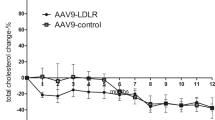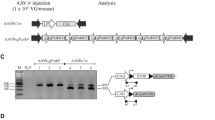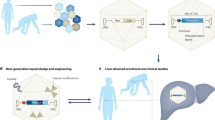Abstract
Familial hypercholesterolemia (FH) caused by defect in low-density lipoprotein receptor (LDLR) is a life-threatening disease with poor response to conventional treatments. Earlier gene therapy studies have generated promising results, but further development is hampered because the cells harboring the viral vectors were eliminated by host immune system soon after delivery, whereas the nonviral vectors were too bulky to be delivered to target cells. To overcome these problems, we constructed multiple minicircle (MC) DNA vectors to express the therapeutic LDLR. MC is an optimized nonviral vector that is capable of expressing high level of transgene product persistently. We found that among the seven MCs tested, the best is MC5 with multiple advanced features. First, the LDLr gene was placed under the control of sterol regulatory element (SRE) using LDLr gene promoter or apoprotein E (ApoE) promoter, allowing the transcription of the LDLr gene to be regulated by serum low-density lipoprotein (LDL) cholesterol as its functional gene counterpart. Second, a hepatic control region (HCR) was placed upstream of the promoter that serves as a controller to ensure liver-specific expression. Third, the modified Kozak sequence was placed in front of the LDLr gene start codon to enhance its translation efficiency. MC5 was 5.23 kb in size, and was capable of tight physiological control in intracellular LDL cholesterol level even when challenged with high dose of sterols in vitro. Importantly, it was able to correct the phenotype of LDLR-deficient mice C57BL/6 LDLR-/- for more than 105 days without detectable toxicity. Therefore, this MC has the clinical application potential for treating FH.
This is a preview of subscription content, access via your institution
Access options
Subscribe to this journal
Receive 12 print issues and online access
$259.00 per year
only $21.58 per issue
Buy this article
- Purchase on Springer Link
- Instant access to full article PDF
Prices may be subject to local taxes which are calculated during checkout



Similar content being viewed by others
References
Brown MS, Goldstein JL . Familial hypercholesterolemia: defective binding of lipoproteins to cultured fibroblasts associated with impaired regulation of 3-hydroxy-3-methylglutaryl coenzyme A reductase activity. Proc Natl Acad Sci USA 1974; 71: 788–792.
Van Craeyveld E, Jacobs F, Gordts SC, De Geest B . Gene therapy for familial hypercholesterolemia. Curr Pharm Des 2011; 17: 2575–2591.
Soutar AK, Naoumova RP . Mechanisms of disease: genetic causes of familial hypercholesterolemia. Nat Clin Pract Cardiovasc Med 2007; 4: 214–225.
Apstein CS, Zilversmit DB, Lees RS, George PK . Effect of intessive plasmapheresis on the plasma cholesterol concentration with familial hypercholesterolemia. Atherosclerosis 1978; 31: 105–115.
Leonard JV, Clarke M, Macartney FJ, Slack J . Progression of atheroma in homozygous familial hypercholesterolaemia during regular plasma exchange. Lancet 1981; 2: 811.
Kassim SH, Li H, Bell P, Somanathan S, Lagor W, Jacobs F et al. Adeno-associated virus serotype 8 gene therapy leads to significant lowering of plasma cholesterol levels in humanized mouse models of homozygous and heterozygous familial hypercholesterolemia. Hum Gene Ther 2013; 24: 19–26.
Ose L . An update on familial hypercholesterolaemia. Ann Med 1999; 31(Suppl 1): 13–18.
Smith JR, Osborne TF, Goldstein JL, Brown MS Identification of nucleotides responsible for enhancer activity of sterol regulatory element in low density lipoprotein receptor gene. J Biol Chem 1990; 265: 2306–2310.
Goldstein JL, DeBose-Boyd RA, Brown MS . Protein sensors for membrane sterols. Cell 2006; 124: 35–46.
Lebherz C, Gao G, Louboutin JP, Millar J, Rader D, Wilson JM . Gene therapy with novel adeno-associated virus vectors substantially diminishes atherosclerosis in a murine model of familial hypercholesterolemia. J Gene Med 2004; 6: 663–672.
Hibbitt OC, McNeil E, Lufino MM, Seymour L, Channon K, Wade-Martins R . Long-term physiologically regulated expression of the low-density lipoprotein receptor in vivo using genomic DNA mini-gene constructs. Mol Ther 2010; 18: 317–326.
Hibbitt OC, Harbottle RP, Waddington SN, Bursill CA, Coutelle C, Channon KM et al. Delivery and long-term expression of a 135 kb LDLR genomic DNA locus in vivo by hydrodynamic tail vein injection. J Gene Med 2007; 9: 488–497.
Chen ZY, Riu E, He CY, Xu H, Kay MA . Silencing of episomal transgene expression in liver by plasmid bacterial backbone DNA is independent of CpG methylation. Mol Ther 2008; 16: 548–556.
Chen ZY, He CY, Ehrhardt A, Kay MA . Minicircle DNA vectors devoid of bacterial DNA result in persistent and high-level transgene expression in vivo. Mol Ther 2003; 8: 495–500.
Kay MA, He CY, Chen ZY . A robust system for production of minicircle DNA vectors. Nat Biotechnol 2010; 28: 1287–1289.
Dietz WM, Skinner NEB, Hamilton SE, Jund MD, Heitfeld SM, Litterman AJ et al. Minicircle DNA is superior to plasmid DNA in eliciting antigen-specific CD8(+) T-cell responses. Mol Ther 2013; 21: 1526–1535.
Jia F, Wilson KD, Sun N, Gupta DM, Huang M, Li Z et al. A nonviral minicircle vector for deriving human iPS cells. Nat Methods 2010; 7: 197–199.
Stenler S, Blomberg P, Smith CE . Safety and efficacy of DNA vaccines: plasmids vs minicircles. Hum Vaccin Immunother 2014; 10: 1306–1308.
Sudhof TC, Goldstein JL, Brown MS, Russell DW . The LDL receptor gene: a mosaic of exons shared with different proteins. Science 1985; 228: 815–822.
Ishibashi S, Brown MS, Goldstein JL, Gerard RD, Hammer RE, Herz J . Hypercholesterolemia in low density lipoprotein receptor knockout mice and its reversal by adenovirus-mediated gene delivery. J Clin Invest 1993; 92: 883–893.
Jacobs F, Van Craeyveld E, Feng Y, Snoeys J, De Geest B . Adenoviral low density lipoprotein receptor attenuates progression of atherosclerosis and decreases tissue cholesterol levels in a murine model of familial hypercholesterolemia. Atherosclerosis 2008; 201: 289–297.
WHO The WHO Expert Committee on Biological Standardization 56th report: Number 941. World Health Organization: Geneva, 2007.
FDA. Guidance for industry: considerations for plasmid DNA vaccines for infectious disease indications. November 2007.
EMEA. Note for Guidance on the Quality, Preclinical and Clinical Aspects of Gene Transfer Medicinal Products: EMEA/273974/2005. London, 17 November 2005.
Stenler S, Wiklander OP, Badal-Tejedor M, Turunen J, Nordin JZ, Hallengard D et al. Micro-minicircle gene therapy: implications of size on fermentation, complexation, shearing resistance, and expression. Mol Ther Nucleic Acids 2014; 2: e140.
Catanese DJ Jr, Fogg JM, Schrock DE 2nd, Gilbert BE, Zechiedrich L . Supercoiled minivector DNA resists shear forces associated with gene therapy delivery. Gene Therapy 2012; 19: 94–100.
Hill AB, Chen M, Chen CK, Pfeifer BA, Jones CH . Overcoming gene-delivery hurdles: physiological considerations for nonviral vectors. Trends Biotechnol 2015; 34: 91–105.
Zhang Y, Satterlee A, Huang L . In vivo gene delivery by nonviral vectors: overcoming hurdles? Mol Ther 2012; 20: 1298–1304.
Hobbs HH, Brown MS, Goldstein JL . Molecular genetics of the LDL receptor gene in familial hypercholesterolemia. Hum Mutat 1992; 1: 445–466.
Sudhof TC, Van der Westhuyzen DR, Goldstein JL, Brown MS, Russell DW . Three direct repeats and a TATA-like sequence are required for regulated expression of the human low density lipoprotein receptor gene. J Biol Chem 1987; 262: 10773–10779.
Dang Q, Walker D, Taylor S, Allan C, Chin P, Fan J et al. Structure of the hepatic control region of the human apolipoprotein E/C-I gene locus. J Biol Chem 1995; 270: 22577–22585.
Long GL, Chandra T, Woo SL, Davie EW, Kurachi K . Complete sequence of the cDNA for human alpha 1-antitrypsin and the gene for the S variant. Biochemistry 1984; 23: 4828–4837.
Kozak M . Pushing the limits of the scanning mechanism for initiation of translation. Gene 2002; 299: 1–34.
Acknowledgements
This work is funded by the Shenzhen Government (Grant Numbers SFG 2012566 and SKC 2012237).
Author contributions
Z-YC perceived the concept and worked with XHH and RJ to design the experiments and write the manuscript. XHH, RJ, TYW, XYG, YSC and C-YH conducted the experiments.
Author information
Authors and Affiliations
Corresponding author
Ethics declarations
Competing interests
The authors declare no conflict of interest.
Additional information
Supplementary Information accompanies this paper on Gene Therapy website
Rights and permissions
About this article
Cite this article
Hou, X., Jiao, R., Guo, X. et al. Construction of minicircle DNA vectors capable of correcting familial hypercholesterolemia phenotype in a LDLR-deficient mouse model. Gene Ther 23, 657–663 (2016). https://doi.org/10.1038/gt.2016.37
Received:
Revised:
Accepted:
Published:
Issue Date:
DOI: https://doi.org/10.1038/gt.2016.37
This article is cited by
-
Gene therapy for monogenic liver diseases: clinical successes, current challenges and future prospects
Journal of Inherited Metabolic Disease (2017)



